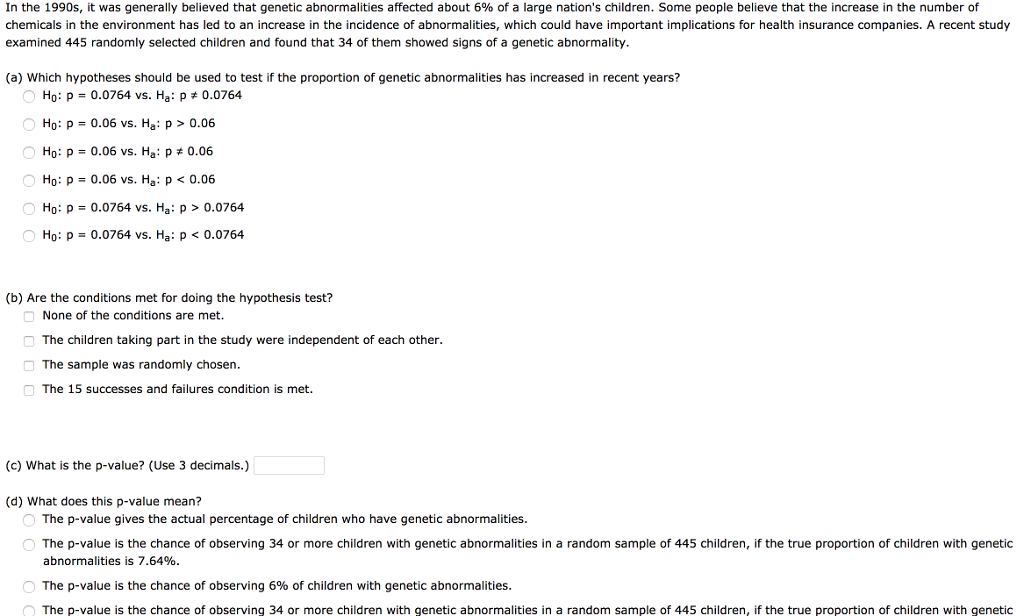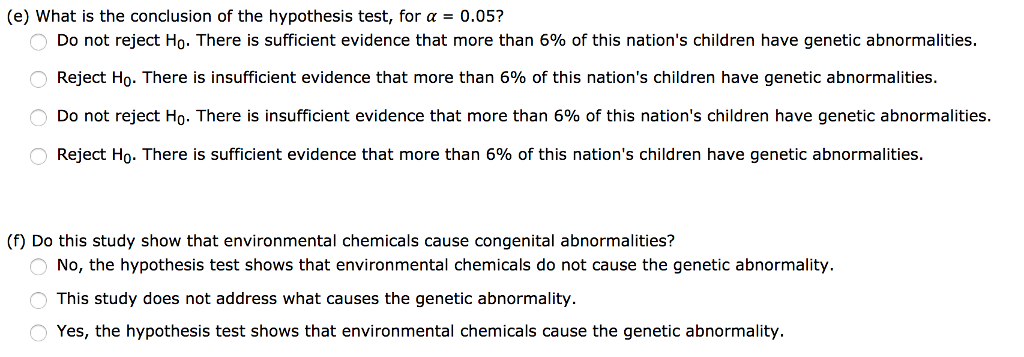Answered step by step
Verified Expert Solution
Question
1 Approved Answer
In the 1990s, it was generally believed that genetic abnormalities affected about 6% of a large nation's children. Some people believe that the increase


In the 1990s, it was generally believed that genetic abnormalities affected about 6% of a large nation's children. Some people believe that the increase in the number of chemicals in the environment has led to an increase in the incidence of abnormalities, which could have important implications for health insurance companies. A recent study examined 445 randomly selected children and found that 34 of them showed signs of a genetic abnormality. (a) Which hypotheses should be used to test if the proportion of genetic abnormalities has increased in recent years? Ho: p= 0.0764 vs. Ha: p = 0.0764 Ho: p= 0.06 vs. Ha: p > 0.06 Ho: P = 0.06 vs. H: p = 0.06 Ho: p = 0.06 vs. Ha: p < 0.06 Ho: p= 0.0764 vs. Ha: p > 0.0764 O Ho: p = 0.0764 vs. Ha: p < 0.0764 (b) Are the conditions met doing the hypothesis test? None of the conditions are met. The children taking part in the study were independent of each other. The sample was randomly chosen. The 15 successes and failures condition is met. (c) What is the p-value? (Use 3 decimals.) (d) What does this p-value mean? O The p-value gives the actual percentage of children who have genetic abnormalities. The p-value is the chance of observing 34 or more children with genetic abnormalities in a random sample of 445 children, if the true proportion of children with genetic abnormalities is 7.64%. The p-value is the chance of observing 6% of children with genetic abnormalities. The p-value is the chance of observing 34 or more children with genetic abnormalities in a random sample of 445 children, if the true proportion of children with genetic (e) What is the conclusion of the hypothesis test, for a = 0.05? O Do not reject Ho. There is sufficient evidence that more than 6% of this nation's children have genetic abnormalities. Reject Ho. There is insufficient evidence that more than 6% of this nation's children have genetic abnormalities. Do not reject Ho. There is insufficient evidence that more than 6% of this nation's children have genetic abnormalities. O Reject Ho. There is sufficient evidence that more than 6% of this nation's children have genetic abnormalities. (f) Do this study show that environmental chemicals cause congenital abnormalities? O No, the hypothesis test shows that environmental chemicals do not cause the genetic abnormality. O This study does not address what causes the genetic abnormality. O Yes, the hypothesis test shows that environmental chemicals cause the genetic abnormality.
Step by Step Solution
★★★★★
3.39 Rating (161 Votes )
There are 3 Steps involved in it
Step: 1

Get Instant Access to Expert-Tailored Solutions
See step-by-step solutions with expert insights and AI powered tools for academic success
Step: 2

Step: 3

Ace Your Homework with AI
Get the answers you need in no time with our AI-driven, step-by-step assistance
Get Started


